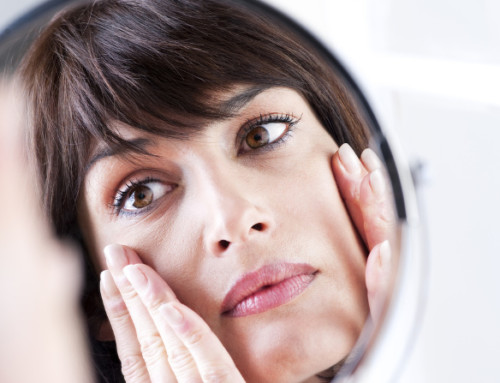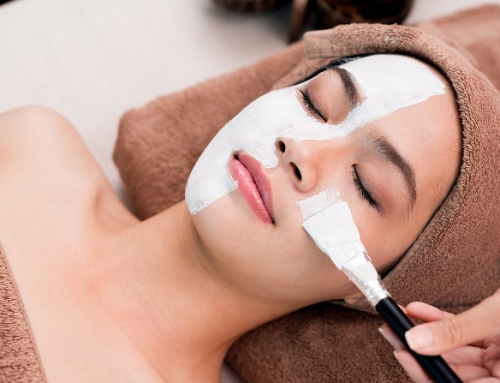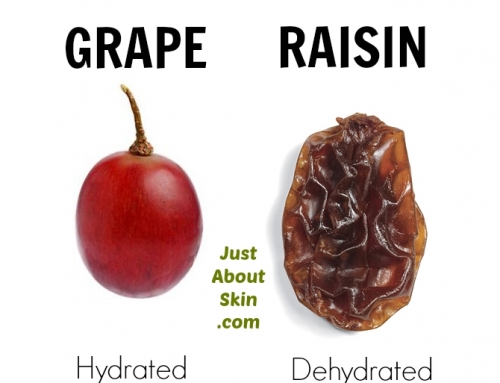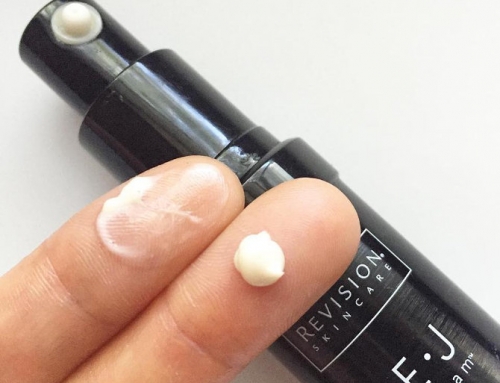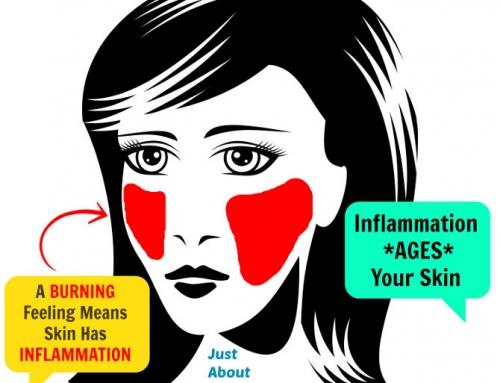Today is the third part of Exfoliation 101 – important risks and precautions when you exfoliate.
For a review on exfoliation, here are other posts:
Exfoliation Risks
Over Exfoliating Damages Skin
Exfoliating skin is helpful for all skin types, and especially for breakout-prone skin that needs help with ‘unroofing’ acne lesions (the top of a plug) and unclogging a pore. But exfoliating too much causes more harm than good.
If you exfoliate too often, you can remove too much skin prematurely. Skin cells take time to regenerate. The normal cell turnover rate is about 28 days in a young adult. It’s double that for someone over age 50.
Over-exfoliating also triggers inflammation in the skin and weakens the barrier function. If the barrier function is damaged, skin becomes vulnerable to infection from microorganisms, such as bacteria and fungus, and sensitivity and irritation.
Even if the barrier function isn’t visibly damaged, the skin may experience a low amount of inflammation (called chronic inflammation), which over time prematurely ages skin.
Signs of Over Exfoliating
- tight skin (both a feeling of tightness and the skin literally looking stretched out and taut)
- translucent skin (as if it were almost sheer)
- shiny skin (as if it were just polished)
- more sensitivity than usual
- irritated skin
- redness
- dryness
Changes in Pigmentation and Scarring
Changes in pigmentation and scarring are potential side effects of strong chemical exfoliation (e.g. deep chemical peel) or invasive exfoliation procedures done in a doctor’s office or medical spa (e.g. dermabrasion, lasers).
Pigmentation can get darker (hyperpigmentation) or lighter (hypopigmentation). These risks are especially high for Fitzpatrick Skin Types 4-6 (darker skin tones).
More info here: Risks for Skin of Color.
How Often Should You Exfoliate?
So what is considered too much exfoliating? That’s a good question, one that is open to debate. There is no definitive answer. If you poll a bunch of estheticians, dermatologists, cosmetic chemists, and skin scientists, you’ll get a range of answers.
Another challenge with answering this question is that there is such a wide range of exfoliation options. Exfoliation can be anything from a mild physical scrub to a deep chemical peel. And everything in between like an exfoliating cleanser or toner.
I personally think there is too much exfoliation in general – too many products containing exfoliating ingredients, a tendency to exfoliate too often, and exfoliation recommendations that aren’t cautious enough.
I am more conservative when it comes to exfoliation because I believe the skin barrier is all-important. A damaged barrier is the root of all skin issues.
Inflammation caused by over-exfoliation causes all sorts of problems, not to mention premature aging. Unless skin is very dull, rough, or congested, there is no need to go crazy with exfoliation.
Anyhow, back to the question. How often you exfoliate largely depends on three factors:
1). The nature of your exfoliant – What are the exfoliating agents? How strong is it (concentration & pH)? Is it an exfoliating cleanser or an exfoliant that you leave on for a certain period of time? Does it have abrasive particles? For example, a scrub is much less invasive than a low pH chemical peel. So a scrub can be used daily but definitely not a chemical peel.
2). Your skin condition – If you have clogged pores, breakouts, underlying congestion, or oily skin, using an exfoliating cleanser or serum daily can help control the congestion and blemishes. It can also improve the texture of badly sun-damaged skin. But if you don’t have those issues, exfoliating daily is both unnecessary and potentially damaging to your barrier.
3). The thickness of your skin – Skin thickness varies by skin type, ethnic ancestry, and lifestyle choices. Darker skin tones tend to have thicker skin. Sun-damaged (photodamaged) skin is also thicker (in the Stratum Corneum). Thicker skin can be exfoliated more frequently than thin skin. Especially thicker skin that is oily.
What is recommended most often is 1-3 times a week for a chemical exfoliant treatment (something that is more potent than a cleanser or serum).
An exfoliating cleanser, toner, or serum can be used daily if you have acne or oily skin. But as I said above, it really depends on the nature of the exfoliant and how aggressive it is.
You should always follow the instructions of the product and not exceed the manufacturer’s recommended frequency or time left on skin.
Considerations For Certain Skin Types
- If you have thin skin or occasional sensitivity, exfoliating once a week is enough for a leave-on chemical exfoliant. You should avoid mechanical exfoliation, as friction with abrasive particles or bristles can damage blood capillaries, which happens more easily on thin skin.
- If you have chronically sensitive or reactive skin, you need to be careful with your choice of exfoliants. Use gentle chemical exfoliants, such as enzymes or possibly lactic acid or mandelic acid. Not glycolic acid, which penetrates deeper into skin due to its smaller molecular size. You should also limit exfoliation to once a week at most.
- If you have inflamed or cystic acne, you will also need a gentle chemical exfoliant. Mechanical exfoliation can irritate acne lesions.
- If you have thick, rough, leathery, or sun-damaged skin, you can exfoliate more frequently (even daily). It’ll just depend on what you’re using.
Always let your skin guide you. You’ll know when it doesn’t feel good. If your skin feels tight or sensitive or looks shiny afterward, then cut back on the frequency.
Rest Periods
In addition to frequency, there’s also debate about rest periods – giving skin a rest from exfoliation after a month or two of consistent exfoliation, and then returning to exfoliation for another month or two. The rest period gives skin a break from an extended state of inflammation.
There is no decisive conclusion on this either.
Make Exfoliation A Habit
I suspect that for most of you, over-exfoliating isn’t the real challenge. The challenge is fitting exfoliation into your skin care routine and making it a regular habit. It does take time and effort to do something that isn’t immediately urgent (like cleansing).
I personally exfoliate once or twice a week using a leave-on chemical exfoliant – an AHA or enzyme-based exfoliant. For my own skin, my preference is for enzymes because they’re gentle and brighten immediately.
I don’t exfoliate more often than that because my skin is naturally thin. The only exception is if my nose is very clogged with blackheads (in the summer time). I’ll spot exfoliate the nose several times a week when I see the need for it.
I try to set aside a night to exfoliate and mask afterward (Sunday evening for example). When you make it a habit (same day and time), it becomes a natural part of your routine over time.
Exfoliating Precautions You Should Take
Here are some precautions to take when you start exfoliating with a new product. Be sure to follow the manufacturer’s instructions. When used incorrectly, chemical exfoliants can harm skin.
1. When you start off using an AHA product, go easy and slow.
Whenever you use an acidic product, skin needs to acclimatize to it. If you’re using an AHA product (which is acidic), follow the manufacturer’s instructions on how often you should apply the exfoliant.
If it is a strong AHA, it is normal for skin to be a little irritated at first. If you experience some warmth, tingling, or mild stinging, don’t panic. Those signs are normal. They should go away within a week of use. For some people, there is no irritation at all.
If you experience immediate pain, intense burning, stinging, or extreme irritation or redness upon applying the product, cleanse your face right away and discontinue use.
If you experience uncomfortable and persistent stinging or irritation that doesn’t go away after a week, stop using the AHA.
Peeling and flakiness is also normal and should go away after multiple applications.
2. Don’t use an AHA or Fruit Acid if you have extremely sensitive or reactive skin, or have a lot of redness on your face.
Exfoliating with acids is too aggressive for extremely sensitive or reactive skin. A better choice would be enzymes, which are more gentle than AHA’s. Consult with an esthetician or dermatologist for alternative treatment recommendations.
You should also proceed with caution with scrubs. Some mechanical exfoliants are gentle enough for sensitive skin (e.g. rice bran powder). But most aren’t. Large particles are too abrasive on sensitive skin. The smaller the particle size, the better. If you can see or feel the particles, chances are they’re too big and abrasive.
3. Don’t exfoliate during the daytime. Exfoliate at night.
AHA’s increase your sensitivity to the sun and make skin more prone to burning (because it thins out the skin). It is therefore better to exfoliate at night.
If you get exfoliated at a spa during the day, avoid being outdoors in bright sunshine after your spa treatment. The esthetician will apply sunscreen, but you should have some on hand to touch up.
4. Wear sunscreen if you’ve exfoliated during the daytime.
You should always wear sunscreen every day. But it’s especially critical to protect your skin from the sun after you exfoliate (whether it’s done at home or the spa).
After being exfoliated, skin is thinner and more vulnerable to the sun’s damaging UV rays. Thinner skin also means a more vulnerable barrier function. Skin is more easily sensitized.
A strong barrier is essential for healthy skin. So it’s important you protect recently exfoliated skin.
5. Use products with anti-inflammatory and soothing ingredients after you’ve exfoliated.
It’s important to minimize any unwanted inflammation that occurs from exfoliation. After you’ve exfoliated, try to use a serum and/or moisturizer that contains anti-inflammatory, soothing, and healing ingredients.
6. Don’t exfoliate your face too often.
If using a leave-on exfoliant (peel, mask) – not more than 3 times a week.
If you have breakouts or bad blackheads, daily use of Salicylic Acid or AHA’s in a cleanser, toner, or serum is fine. But follow the manufacturer’s instructions on frequency.
If using a mechanical (physical) exfoliant, like a non-abrasive facial scrub or sonic cleansing brush, you can probably exfoliate every day if your skin is NOT in trauma and: you have thick/rough/sun-damaged, you wear a lot of makeup, or you are prone to clogged pores or breakouts (but not if you have inflammatory acne, i.e. Grades 3 or 4). Otherwise, a few times a week is enough.
On dry, cracked, flaky parts of your body, such as feet, legs, or elbows – you can exfoliate as often as needed since the skin is thicker on those parts of the body.
Exfoliation is a big topic that I will return to from time to time. I have tried to cover the basics here to give you a broad understanding of what it can do for your skin. If you have questions or want to learn more, just let me know!




